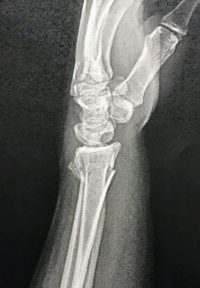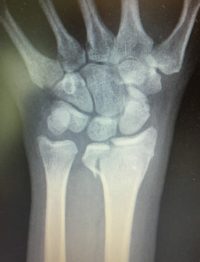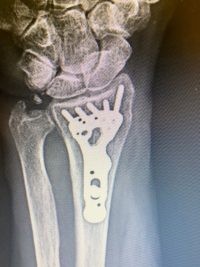Distal radius fractures are one of the most common fractures of the wrist. The radius is the most commonly broken bone in the arm. The distal radius is important because it makes up the portion of the wrist joint that allows you to flex and extend your wrist. The unique anatomy of the wrist allows for rotation, side-to-side movement, flexion, and extension. A break, or fracture, of the distal radius can limit the ability to perform these important motions.
Most distal radius fractures occur with a fall onto an outstretched arm. Initial management usually includes splinting to stabilize the fracture. If the fracture is significantly displaced, a reduction may be necessary to take pressure off of the soft tissue and nerves. Sometimes, the injury and positioning of the fracture can cause carpal tunnel syndrome. This may require surgical release to relieve pressure on the nerve and prevent nerve damage.
Types of fractures
Extra-articular fractures are injuries that occur outside the joint. Even though the joint is not involved, the alignment of the fracture can alter the function of the wrist joint.

Extra-articular distal radius fracture
Intra-articular fractures extend into the joints. If the joint surface is disrupted, development of arthritis can occur. Intra-articular fractures are much more likely to need surgery to appropriately align the joint surfaces and minimize the risk of pain and arthritis in the future.

Intra-articular distal radius fracture
Treatment options
The goal of treatment is to restore or maintain alignment of the wrist. The recommended treatment is based on a combination of factors, including fracture pattern, alignment, articular (joint) involvement, age, and activity level.
Non-surgical management
Non-surgical management is commonly indicated for fractures that are lined up well (non-displaced) or minimally displaced. Management usually consists of a cast or fitted brace for approximately 6 weeks. This allows time for the fracture to heal without the fracture moving out of place. At 6 weeks, therapy is initiated to regain as much motion as possible. As motion improves and fracture continues to heal, we are able to start regaining strength. We expect most patients to be fully recovered by about 3 months after injury.
Surgery
Surgery is necessary when there is significant angulation of the fracture, or if there is joint involvement and articular step-off. There are multiple surgical options including closed reduction and casting, pinning, plating, and external fixators. The most common way to fix these fractures is with a plate and screws. We call this volar plating. Volar means the plate goes on the palm side of the wrist. One benefit of volar plating is we can start motion shortly after surgery to restore as much motion as possible. Plates have been developed that fit the exact anatomy of the distal radius. This allows us to place the plate directly against the bone, rarely causing any irritation to the tendons, nerves, and muscles of the wrist. In a very small percentage of patients, the plate causes an irritation and we take it out after the fracture has healed.

Distal radius volar plate
Surgery logistics
Surgery is usually performed at an outpatient surgery center and patients go home the same day. Most patients receive a light general anesthesia and a regional block for postoperative pain control. Pain medications may be prescribed for a couple of days after surgery.
Recovery after surgery
After surgery, the wrist is splinted for two weeks. The fingers and elbows are free to move and finger motion is encouraged to help minimize swelling and stiffness. Lifting is limited to less than 1 pound until the fracture is healed. At the initial follow-up visit 2 weeks after surgery, the splint is removed to start working on wrist motion. The plate provides enough stability for early motion. A brace is fitted to wear only for protection. This involves home exercises and physical therapy to help obtain the best outcome. We expect the broken bone to heal about 6 weeks after surgery. We take x-rays every few weeks until the bone is fully healed.
Outcomes
Most patients are able to return to all of their former activities after they have recovered from a distal radius fracture. It is not uncommon to have some mild stiffness in the wrist. Stretching and complying with treatment recommendations helps to minimize stiffness. Once the bone is healed, we encourage return to all previous activities and sports without restrictions.
Diagrams modified from ASSH (www.assh.org)
